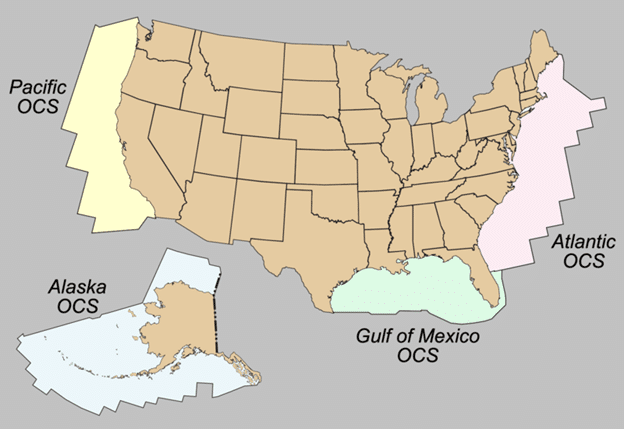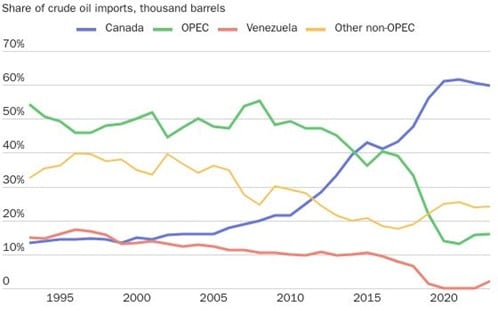With roughly 129 million Americans living along its coasts, the earth’s ocean has long played a crucial role in supporting economic and personal activities. One activity that coastal states have been particularly interested in is exploring offshore wind farms. They’ve been seeking to tap into the resource due to the energy potential of 1.5 terawatts from fixed-bottom and 2.8 terawatts from floating offshore wind farms. That enthusiasm has led to a $10 billion federal investment towards the offshore wind supply chain.
On January 20, 2025, however, the White House issued President Donald Trump’s directive on offshore wind research and project development in states around the country. Pertaining to offshore wind farms, “we are going to make sure that ends on day one,” President Trump stated. The executive order, despite seemingly ending offshore wind progression, does not fully fulfill his previous promise. Therefore, states hoping to add offshore wind to their mix of renewable energy sources may still have hope.
Breaking Down The Executive Order
Section one highlights the government’s role as a responsible public steward, with a focus on protecting marine habitats, addressing economic energy needs — particularly those that are inaccessible — and guaranteeing the fishing industry’s long-term viability. Which was why wind energy leasing on the Outer Continental Shelf (OCS) has been temporarily unavailable since January for new or renewed leases unless the memorandum is repealed. Other area usage intentions, including those related to minerals, oil, gas and the environment, were seen to be excluded from this directive.
Due to the OCS Lands Act, 43 U.S.C. § 1331 under section 12(a), the president may occasionally make certain unleased land areas within the OCS unavailable (Figure 1). Donald Trump’s last presidential term, during which he prevented the consideration of lease projects excluding environmental conservation, remains in place in portions of the Atlantic and Gulf of Mexico until 2032. This current executive order extends to the unavailable areas.
Figure 1. The United States Outer Continental Shelf Coverage

Source: U.S. Department of the Interior – Minerals Management Service – image extracted from http://www.mms.gov/revaldiv/PDFs/2006NationalAssessmentBrochure.pdf
Section two indicates that, while the executive order withdrawal will have no effect on current offshore wind leases, both offshore and onshore wind licenses will now undergo extensive assessments. To decide whether the current wind energy leases need to be terminated or modified legally, these assessments will conduct an ecological, economic and environmental examination. The Secretary of the Interior and the Attorney General will undertake these, and then provide a report of recommendations to the President via the Assistant to the President for Economic Policy.
Environmental authorities are not permitted to provide new or renewed wind approvals until a comprehensive assessment is completed — that includes a review of federal wind leasing and permitting processes. The remainder of section two discusses the halting of the Lava Ridge Wind Project, which would have built 241 wind turbines. The project, which would have spanned over 100,000 acres across three Idaho counties, is presently undergoing a thorough evaluation.
Due to unresolved concerns, Idaho Gov. Brad Little has agreed to the requirements regarding the Lava Ridge Project and has directed full cooperation towards these evaluations, including the promise of public input throughout the process.
Considering All the Impacts
Any energy project must be carefully considered to reduce any negative effects, and offshore wind developments are no exception. For this reason, the U.S. Department of Energy (USEER) and Tethys repository are just two of the resources that have been covering efforts to address supply chain concerns like environmental impacts for years. Furthermore, 90% of the mass of wind turbines and wind systems is presently recyclable, with the Wind Energy Tech Recycling Research & Development program seeking to find new ways to reuse parts.
The presidential directive may also influence job security and the workforce. More than 131,000 people currently work in the wind industry nationwide, according to the USSER 2024 Energy and Employment Job Report.
In comparison, the executive order excludes oil and gas activity impacts, which do not address repercussions such as oil spills, noise pollution, and air pollution, all of which impair marine life habitats.
Furthermore, due to tariff uncertainty, the economics of oil and gas resource pricing must be considered. The U.S. sources around 60% of crude oil imports from Canada (Figure 2). Tariff increases could affect the 70% of U.S. refineries that are designed to run heavier grades of crude oil especially from Canada, our largest supplier. This decision might cost billions of dollars to modify infrastructure and raise customer energy costs.
Figure 2. U.S. Imports of Crude Oil by Country

Source: Lincicome, S., & Obregon, A. C. (2025, February 28). Eleven Charts Showing How Canada/Mexico Tariffs Would Harm the US Energy Industry (and US Energy Consumers). Cato.org.
Source: “US Imports by Country of Origin,” Energy Information Administration, updated January 31, 2025.
What’s Next: Hope for Wind?
Despite the setback from the presidential directive, eight federally permitted, commercial-scale offshore projects on the east coast appear to be safe as cited by offshore wind reporter Clare Fieseler from Canary Media. Projects, including the Coastal Virginia Offshore Wind Project and the Empire Wind Project in New York, are still proceeding with construction development this year.
West Coast states, such as California, have been working to integrate marine energy technology into their energy portfolio, including plans for floating offshore wind. They are still in the early phases, with the state’s submission of federal approval permits not expected until closer to 2030. Executive director of the industry association Offshore Wind California, Adam Stern, told CalMatters that “as an industry, we’re focused on what is advancing offshore wind in California, and right now, most of that is happening at the state level.”
As of today, the executive order is not a complete ban on wind energy technologies. There are projects still underway at the state level to continue forward with incorporating wind technology within the grid. Clarification of rapidly changing regulations will be crucial to preventing the spread of misinformation from eye-catching headlines, as the drive for a more conscientious energy future may still be in the wind.

